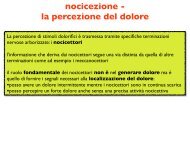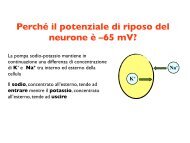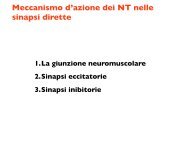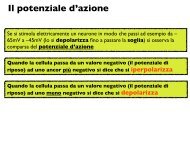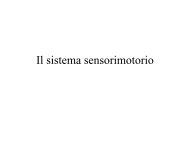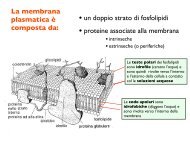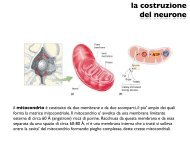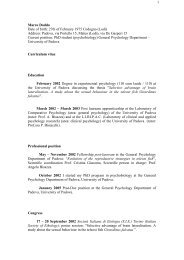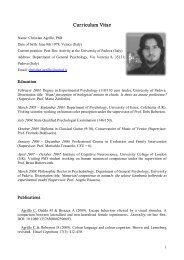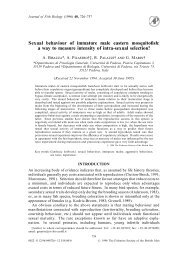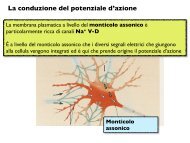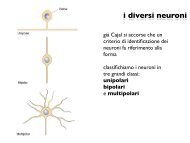Visual lateralization in response to familiar and unfamiliar ... - CPRG
Visual lateralization in response to familiar and unfamiliar ... - CPRG
Visual lateralization in response to familiar and unfamiliar ... - CPRG
You also want an ePaper? Increase the reach of your titles
YUMPU automatically turns print PDFs into web optimized ePapers that Google loves.
386 V.A. Sovrano / Behavioural Bra<strong>in</strong> Research 152 (2004) 385–391<br />
look<strong>in</strong>g at their own image <strong>in</strong> a mirror is not a manifestation<br />
of a generic preference <strong>to</strong> use this eye <strong>to</strong> look at all visual<br />
stimuli because the right eye is used <strong>in</strong> preference <strong>in</strong> other<br />
tasks, for <strong>in</strong>stance <strong>to</strong> <strong>in</strong>spect a preda<strong>to</strong>r or other potentially<br />
dangerous stimuli [8] or when decid<strong>in</strong>g <strong>to</strong> perform a certa<strong>in</strong><br />
course of action on a stimulus, such as <strong>to</strong> bite it [11]. However,<br />
it is unclear what specific aspects of the mirror-image<br />
would attract the attention of the left eye <strong>and</strong> the associated<br />
neural structures. Here we have started an <strong>in</strong>vestigation<br />
of this issue. In the first experiment we tried <strong>to</strong> check<br />
whether the degree of <strong>familiar</strong>ity with the images provided<br />
by a mirror would affect the lateral bias. For a naïve fish,<br />
its mirror-image is the image of a stranger conspecific. Do<br />
fish accus<strong>to</strong>med <strong>to</strong> a mirror would still manifest a left lateral<br />
bias <strong>in</strong> the use of the eyes?<br />
2. Experiment 1<br />
All evidence collected so far concerned fish that were<br />
presented for the first time with a mirror. In the present<br />
experiment fish were tested after a long exposure <strong>to</strong> a mirror.<br />
As a control, we also devised an experimental condition <strong>in</strong><br />
which fish were exposed, for the same amount of time, <strong>to</strong> the<br />
same number of conspecifics see<strong>in</strong>g as real animals beh<strong>in</strong>d<br />
a glass rather than as images <strong>in</strong> a mirror.<br />
2.1. Materials <strong>and</strong> methods<br />
2.1.1. Subjects<br />
Females of Xenopoecilus saras<strong>in</strong>orum (N = 24) were<br />
used. Fish were kept <strong>in</strong><strong>to</strong> vegetation rich (Cera<strong>to</strong>phyllum<br />
sp.) 120–150 l glass tanks (99 cm × 45 cm × 52.5 cm), illum<strong>in</strong>ated<br />
from above by fluorescent lamps (30 W) under a<br />
14:00-h light:10:00-h dark period. Water temperature was<br />
ma<strong>in</strong>ta<strong>in</strong>ed between 22 <strong>and</strong> 25 ◦ C <strong>and</strong> fish were fed dry food<br />
twice a day.<br />
2.1.2. Apparatus <strong>and</strong> procedure<br />
Twenty-one days before the start of the test fish were removed<br />
from the communal tank <strong>and</strong> r<strong>and</strong>omly subdivided<br />
<strong>in</strong> two different rear<strong>in</strong>g conditions (see Fig. 1). In one condition<br />
(N = 12) fish were placed <strong>in</strong> groups of three animals<br />
<strong>in</strong> smaller rectangular glass tanks (48 cm × 19 cm × 32 cm),<br />
covered with opaque plastic material, with one of the longer<br />
wall entirely occupied by a mirror (48 cm × 27 cm). In the<br />
other condition (N = 12) fish were placed <strong>in</strong> groups of three<br />
animals <strong>in</strong> tanks identical <strong>to</strong> those used <strong>in</strong> the other condition.<br />
However, this time there was no mirror along the longer<br />
wall, which was <strong>in</strong>stead occupied by a transparent glass wall<br />
of an adjacent tank (see Fig. 1), so that the fish could be exposed<br />
<strong>to</strong> an environment similar <strong>to</strong> that of the fish exposed<br />
<strong>to</strong> the mirror (i.e. they could see three conspecifics on the<br />
other side <strong>and</strong> the mirror-image of the tank).<br />
The apparatus has been described <strong>in</strong> details elsewhere<br />
[18]. Test<strong>in</strong>g was performed with<strong>in</strong> a tank (44 cm ×22 cm ×<br />
30 cm), <strong>in</strong>serted <strong>in</strong><strong>to</strong> a larger tank (60 cm × 36 cm × 35 cm),<br />
with mirrors as the two longer walls <strong>and</strong> opaque screens as<br />
the shorter walls (see Fig. 2). The tank was lit from above<br />
by a neon lamp (18 W); water was 25 cm <strong>in</strong> height. Above<br />
the test<strong>in</strong>g apparatus a videocamera was mounted <strong>in</strong> order<br />
<strong>to</strong> videotape the fish behaviour. Fish exposed <strong>to</strong> the mirror<br />
<strong>and</strong> fish exposed <strong>to</strong> conspecifics were tested <strong>in</strong> the same<br />
way. Each fish was tested s<strong>in</strong>gly, by plac<strong>in</strong>g it <strong>in</strong><strong>to</strong> the test<br />
apparatus <strong>and</strong> videorecord<strong>in</strong>g its behaviour for 15 m<strong>in</strong> (for<br />
subsequent analysis, this period was split <strong>in</strong><strong>to</strong> three blocks<br />
of 5 m<strong>in</strong> <strong>in</strong> order <strong>to</strong> check for variation <strong>in</strong> <strong>lateralization</strong> as<br />
a function of time). Fish positions were then scored every<br />
2 s, <strong>and</strong> the frequency of use of the left- or right-monocular<br />
visual field was estimated on the basis of the fish angle with<br />
respect <strong>to</strong> the closest mirror (see Fig. 2 <strong>and</strong> [18] for details].<br />
An <strong>in</strong>dex of eye use was calculated as: [(frequency<br />
of right-eye use)/(frequency of right-eye use + frequency<br />
of left-eye use)] × 100. Significant departures from chance<br />
level (50%) were estimated by one- or two-tailed one sam-<br />
Fig. 1. Schematic representation of the rear<strong>in</strong>g conditions used <strong>in</strong> Experiment 1.



